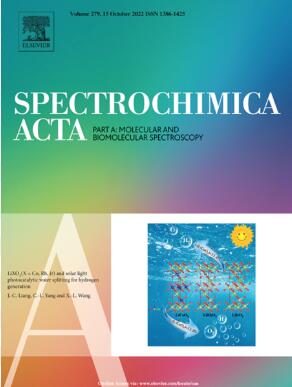Surface-enhanced infrared absorption (SEIRA) based on Metasurface: Principles, biochemical sensing applications, and future perspective
IF 4.6
2区 化学
Q1 SPECTROSCOPY
Spectrochimica Acta Part A: Molecular and Biomolecular Spectroscopy
Pub Date : 2025-06-30
DOI:10.1016/j.saa.2025.126621
引用次数: 0
Abstract
As a powerful analytical technique, surface-enhanced infrared absorption (SEIRA) typically employs periodic nanostructured arrays to generate highly localized and intense electromagnetic near-field enhancements. Infrared vibrations of target sensing molecules located in these periodic nanostructured fields are enhanced by orders of magnitude enabling a spectroscopic characterization with unprecedented sensitivity. This remarkable enhancement effect enables SEIRA to overcome the inherent limitations of conventional infrared spectroscopy, particularly the small molecular absorption cross-sections. Owing to its superior performance characteristics, SEIRA has found extensive applications in biological and chemical sensing domains. This review begins with a concise overview of the historical development and fundamental basis of SEIRA technology. Subsequently, we discuss the underlying principles and mechanisms of metal and dielectric metasurfaces in SEIRA applications. Following these fundamentals, different applications based on SEIRA chemical sensors and biosensors for various target analytes are reviewed. Finally, the current challenges and prospects of SEIRA in biochemical detection are presented, highlighting potential strategies to expand its application scope.

基于metassurface的表面增强红外吸收(SEIRA):原理、生化传感应用及未来展望
作为一种强大的分析技术,表面增强红外吸收(SEIRA)通常采用周期性纳米结构阵列来产生高度局域和强烈的电磁近场增强。位于这些周期性纳米结构场的目标传感分子的红外振动被增强了几个数量级,从而使光谱表征具有前所未有的灵敏度。这种显著的增强效果使SEIRA克服了传统红外光谱的固有局限性,特别是小分子吸收截面。由于其优越的性能特点,SEIRA在生物和化学传感领域得到了广泛的应用。本文首先简要介绍了SEIRA技术的历史发展和基本基础。随后,我们讨论了金属和介电超表面在SEIRA应用中的基本原理和机制。在此基础上,综述了基于SEIRA化学传感器和生物传感器在各种目标分析物中的不同应用。最后,介绍了目前SEIRA在生化检测中的挑战和前景,并指出了扩大其应用范围的潜在策略。
本文章由计算机程序翻译,如有差异,请以英文原文为准。
求助全文
约1分钟内获得全文
求助全文
来源期刊
CiteScore
8.40
自引率
11.40%
发文量
1364
审稿时长
40 days
期刊介绍:
Spectrochimica Acta, Part A: Molecular and Biomolecular Spectroscopy (SAA) is an interdisciplinary journal which spans from basic to applied aspects of optical spectroscopy in chemistry, medicine, biology, and materials science.
The journal publishes original scientific papers that feature high-quality spectroscopic data and analysis. From the broad range of optical spectroscopies, the emphasis is on electronic, vibrational or rotational spectra of molecules, rather than on spectroscopy based on magnetic moments.
Criteria for publication in SAA are novelty, uniqueness, and outstanding quality. Routine applications of spectroscopic techniques and computational methods are not appropriate.
Topics of particular interest of Spectrochimica Acta Part A include, but are not limited to:
Spectroscopy and dynamics of bioanalytical, biomedical, environmental, and atmospheric sciences,
Novel experimental techniques or instrumentation for molecular spectroscopy,
Novel theoretical and computational methods,
Novel applications in photochemistry and photobiology,
Novel interpretational approaches as well as advances in data analysis based on electronic or vibrational spectroscopy.

 求助内容:
求助内容: 应助结果提醒方式:
应助结果提醒方式:


